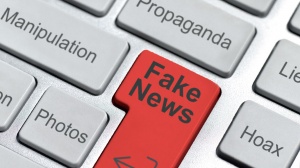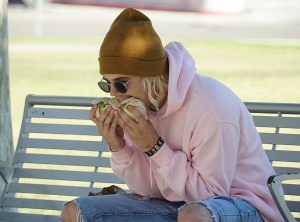Fake News
Fake News is a fairly new term given to certain news articles, web posts, pictures, etc.. that intentionally try to spread false information. This false information is usually aimed at damaging a large entity or famous person, however anyone could fall victim. Media platforms historically have always had ethical dilemmas (i.e. Yellow Journalism, sloppy journalism, etc.) but the emergence of social media and modern fake news has ushered in a new era of ethical concerns. There are many reasons to create fake news articles but the main ones are to discredit/damage someone or something, to make money off the spreading of the article itself, or simply to get a good laugh out of it.
Contents
Background
History
Fake news became a commonly used term in late 2016 - early 2017 when the U.S. presidential candidates, Hillary Clinton and Donald Trump, began to use it in speeches and social media posts. Who coined the term first is difficult to trace but the origin of the first big fake news articles stemmed from the small town Veles, Macedonia.[1] It appears that the young adults of Veles figured out a get-rich-quick scheme by pumping out fake news articles to Facebook to gain the advertising money available on the site. Thus a group of teenagers from Macedonia introduced fake news to the general U.S. public, writing many articles mainly centered around the 2016 U.S. presidential election. Being the hottest topic of mid-late 2016, any kind of fake news article about Hillary Clinton or Donald Trump was sure to sell online. Stories such as "Pope Francis endorses Donald Trump" and "FBI Agent in Clinton email case found dead" went viral instantly. The Macedonians demonstrated to the world that intentionally deceitful articles centered around popular figure heads sell.
Types
Fake news comes in many different forms, there are six easily identifiable types of it: Click bait, Propaganda, Satire, Sloppy Journalism, Misleading Headlines, and Biased News.[2] Click bait is defined as stories that intentionally use a ridiculous headline to gain site views at the price of truth and actual content. Propaganda is intentionally writing a story in a biased slant in order to achieve some agenda. Satirical fake news is created with the intention of entertainment and comedy. Sloppy Journalism occurs when the writer of an article/post uses unreliable sources containing fake news, it's not necessarily the writer's fault for spreading fake news case but it is their fault for not double-checking their sources. Misleading headlines are similar to Click bait but with more substance within the article. Finally, Biased News stories are created to appeal to people's pre-existing beliefs. Unlike propaganda, these articles are written to gain attention not necessarily to shift beliefs.
Ethical problems with Fake News
Mental and Physical Damage
The writers/creators of fake news are usually intentionally deceiving their audiences in one manner or another. It can be for monetary or political gain or simply out of boredom. Either way, the writers are misleading their audiences and causing massive problems. Christopher Blair is a prime example of someone who was bored one day and decided to start writing fake news articles to get a kick out of people's reactions. Blair created his own Facebook page, America's Last Line of Defense -a right-wing satirical page, where he publishes several articles a day, each making some ridiculous claim either promoting or demonizing a political figure.[3] Blair's page does contain a warning that the posts are not real but for many readers, this warning goes unnoticed. A vast majority of Blair's readers are adults and elderly people, many of which struggle to distinguish real and fake news online. What Blair is doing is very common online, there are a vast amount of writers who test their skills with online satire online in order to get reactions or gain advertisement money. Serious damage can come from these sorts of sites, most of the readers are not aware that the articles that they're internalizing and sharing are actually fake. Coming to this realization can be difficult for the reader, as Harry Frankfurt notes: "When someone is lied to by a person they trust, it causes them to look inwards on their own decision making to see who they can trust."[4]. In other words, many people trust and believe that articles such as Blair's tell the truth, and when they're proven wrong, it can be difficult for them to believe any kind of news in the future. Fake news can also lead to violent interactions in the real world as observed in the Pizza Gate scandal in 2016, where a man barged into a pizza shop in Washington D.C. with a rifle in order to free the child sex slaves he believed to be hidden in the basement.[5] The man fired several shots in the ceiling, no one was hurt but this incident only occurred because the man truly believed a fake news article. Incidents of mental and even physical damage have chances of occurring as long as the readers of fake news truly believe in what they're reading. A grain of salt is needed with articles today to avoid damages of any kind.
The circulation of fake news also poses a danger to society. Current technology companies value clicks over content. This issue has pushed any article with the most clicks to the top of most peoples' news feed. However, often the articles with the most clicks are also fake news because the headlines are designed to be clickbait. Valuing clicks over content is a problem because it pushes honest news to the bottom of news feeds, thereby encouraging fake news.
Proving a point?
Fake news articles seem to gravitate around celebrities, after all stories about popular individuals will gain more attention than one about George Johnson from Iowa. Justin Bieber has been a headline-worthy celebrity for quite some time, so a YouTube channel known as Yes Theory decided to do a "challenge", to see if they could get a fake news article -about Justin- to go viral. They decided they would hire a Justin Bieber look-a-like, dress him up to look even more the part, and have him do several mildly infuriating things around Los Angeles.[6] One of the infuriating actions they had the pretend Bieber do was to sit on a park bench and eat a Chipotle burrito from the middle instead of the ends as most people do. The group sent the photos to news editors and posted them online and within 48 hours, the picture was trending on Twitter, Reddit, and was featured on several news channels. The Yes Theory crew had achieved their goal of seeing if they could trick the world. The picture was taken with the intent to deceive but was done in a different sort of manner, not to achieve personal fame or money but to simply see if they could achieve a viral post. The extremity of the picture differs drastically from articles such as Blair's, a simple photo of a celebrity doing something weird as opposed to a leading politician running a child-sex ring. However, reinforcing Frankfurt's point, lies can hurt people and it is possible that people will not be as willing to believe these kinds of posts when they emerge next time. As for the news sites and shows that showcased the photo, their credibility may have taken a knock in the process.
References
- ↑ Wendling, Mike. “The (Almost) Complete History of 'Fake News'.” BBC News, BBC, 22 Jan. 2018, www.bbc.com/news/blogs-trending-42724320.
- ↑ “Explained: What Is Fake News? | Social Media and Filter Bubbles.” Webwise.ie, 2 July 2018, www.webwise.ie/teachers/what-is-fake-news/.
- ↑ Saslow, Eli. “'Nothing on This Page Is Real': How Lies Become Truth in Online America.” The Washington Post, WP Company, 17 Nov. 2018, www.washingtonpost.com/national/nothing-on-this-page-is-real-how-lies-become-truth-in-online-america/2018/11/17/edd44cc8-e85a-11e8-bbdb-72fdbf9d4fed_story.html.
- ↑ Frankfurt, Harry. “On Truth, Lies, and Bullshit.” The Philosophy of Deception, by Clancy W. Martin, Oxford University Press, 2009, pp. 43
- ↑ Tandoc, Edson C, et al. “Defining ‘Fake News.’” Digital Journalism, 30 Aug. 2017.
- ↑ Theory, Yes, director. We Fooled the Internet w/ Fake Justin Bieber Burrito Photo. YouTube, YouTube, 28 Oct. 2018, www.youtube.com/watch?v=Vs6In7UtyXY.

